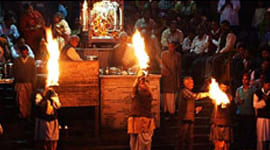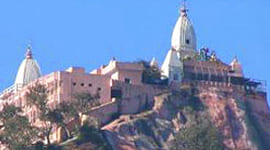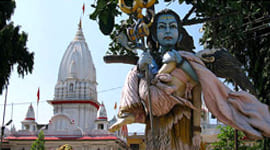Feel Tourism offers to visit Ashrams, temples, experience Ganga Aarti ceremony on the bank of Ganges and test Indian cuisine In the morning around 9AM we will meet at Swami Vivekanand Park in Haridwar. We will start the experience by visiting various places like Mansa Devi temple, Sapt Rishi temple, Daksha Mahadev temple & Ashram, etc. After we will have lunch, enjoying the local foods. After lunch will will continue to visit ashrams and temples located in Haridwar. To complete the experience, in the evening during sunset we will participate in the Maha Aarti (pooja ceremony) which takes place at Har Ki Pauri, the most famous ghat on the banks of the Ganges. Haridwar is the gateway to the four pilgrimages in the Uttarakhand Himalayan region and is located on the foothills of Shivaliks. It is on the banks of River Ganges. The River Ganges leaves the mountains and enters the plains with Haridwar being the first major town on the plains. Though the Ganges does not lose its rapids completely nevertheless it becomes very quite and calm here. The city acquires a unique charm in the evening when the ghats become breathtakingly beautiful with thousands of Diyas and Marigold floating in the waters of Ganga River.

The history of Haridwar, an old city in India, and a subject that arouses great interest in the minds of researchers and scholars. Vedic history describes Haridwar as the land of liberation. This is the place where the Ganges meets the plains and forms the gateway to the various pilgrimage centers of the holy land of Uttarakhand / Uttarakhand. It is also the land of Lord Shiva and the land of Lord Vishnu. It is also known as the land of power - the city of Mayapuri is also recognized under the names Mayapuri, Gangadwar and Kapila and is actually Gateway of the Gods.
History of Haridwar
Haridwar is an ancient city in the state of Uttarakhand in India. It is considered the holiest city in India for many pilgrimage sites. This holy city is a treasure of India's complex culture and ancient civilization. It is said in Hindu mythos that the professionals of Hinduism named it Haridwar.This place is also the gate of Dev Bhoomi and Char Dham, Haridwar has four places of worship - Gangotri, Yamunotri, Kedarnathji and Badrinath. The site is situated on the top of the Shivalikas. The ancient pilgrimage town of Haridwar is also mentioned in several Puranas, Upanishads, Mahabharata and Vanaparva chapters.
This land, which resonates with the continuous chants of 'Alakh Niranjan', 'Har Har Mahadev' and 'Jai Ganga Maiya' and the sound of bells from temples, celebrates the devotion of pilgrims from all over the world. This is a concrete proof of Hindu culture, which constantly strives to seek liberation amidst chaos, pain and confusion. Haridwar is an ideal pilgrimage center for those who are concerned about death and liberation of will. It is also the first place for religious scholars and intellectuals.
By the 15th century, the place was famous as both Hardwar and Haridwar. According to the story of King Daksha and his religious sacrifice in ‘Skanda Purana’, the navel of the destroyed body of Goddess Sati fell here. As a result, a council of Goddess Sati came to the region. Therefore, Haridwar was geographically developed as a natural area of the Goddess. In recent times, if one believes that the temple is the main point of the triangle, then Chandi Devi and Mansa Devi will be the other two points of the triangle. If one joins these three points, an inverted triangle is formed. Devi's followers believe that the inverted triangles represent Shakti (Goddess Sati or Shakti) and the upright triangle represents Lord Shiva.
Mythological mention and importance of Haridwar
Mythological accounts report that the process of ‘Samandra Manthan’, or the churning of the ocean, was done during a war between gods and demons. During this process the demons held the fund of 'Amrit'. A few drops fell on the earth in pursuit to retrieve the nectar. The four places where 'Amrit' drops fell are Haridwar, Ujjain, Nashik and Allahabad in prayer.
This is the reason that Kumbh Mela is organized every three years at these places. Hence it is held every twelve years as Mahakumbh in Haridwar. The place where 'Amrit' fell was in the Brahma Kund which was in the vicinity of Har or literally can say 'Ladder to Swami'. It is considered the most sacred place where bathing can lead one to attain eternal liberation or salvation.
Haridwar is also mentioned in the Mahabharata where sage Dhaumya introduces Yudhishthra to the important pilgrimages of India, the most important of which mentions Haridwar Kankhal. Another famous sage, Kapila, is said to have an ashram in Haridwar which he named Kopilasthana.
Haridwar is also a holy site where King Bhagithan is an ancestor of Lord Rama. He performed severe penance to bring Ganga down from the sky and salvation of his 60,000 ancestors, who were cursed by Bai sage Kapila. Salvation from this ritual is performed by all Hindus till date, as they immerse themselves in the holy Ganges The mortals of dear departed relatives shed ashes.
Every Pauri is considered to be a place where the footprint of Lord Vishnu is inscribed and where it is constantly caressed in the waters of the Ganges.
Historical Chronology of Haridwar
The earliest mention of Haridwar in history was in 322–185 BC when it was under the Maurya Empire. 6 9 A.A. to Haridwar. It is mentioned in the visit of the Chinese traveler Hiuan Tsang, when he was in the reign of King Harshavardhana. Important in his memory is the presence of the 'Ganga' or entrance to the Ganges temple.
The biography of Akbar Mughal emperor 'Ain-e-Akbari' written by Abdul Fazl in which Haridwar is called Maya or Mayapuri. Akbar recognized the importance of Ganga water as 'water of immortality' and ordered that he be provided with sealed water, so that he could drink it as far as he traveled.
Later Raja Man Singh of Amber laid the foundation stone of Haridwar. Later, two dams were constructed on the river Ganges. One of them is called Bhimgoda. The construction of the river had a serious impact on the construction of the dam. It is said that before the construction of the dam, the water was too high to reach Tehri in Garhwal, making it a port.
It is also known that the priests responsible for performing various rituals at Pandas or Haridwar are also the keepers of records from various families in northern India. The pandas have maintained genealogical records in huge 'pothis' which are rolled up and kept away. It is interesting to note that most families in North India have recorded their journey to Haridwar with these pandas. The pandas of each family have their own lineage who are responsible for maintaining their records.
Haridwar as place of learning
Haridwar is famous worldwide for some old and some new things of its old Gurukul. Haridwar can be considered as a place of learning where innumerable institutions have been set up to impart education. Institutions can also be dedicated to carry forward the Vedic traditions and the Guru-disciple tradition.
All forms of learning on science and culture are given in many institutions in Haridwar. The most important among the traditional institution is Gurukul Kangri which has been operational since 1902.
Haridwar is known as a miraculous storehouse of naturally used, medicinal flora and fauna, which are prevalent in many of its traditional traditions.
Importance of holy Ganges
Lord Krishna has said in His Holiness Srimad Bhagavat Gita - 'Nadiya Mera Mein Ganga Hun' means that I am the Ganges above all rivers. This statement proves the importance of the holy river Ganga, which is said to have originated on the tenth day of the Jyestha month (the third month of the Hindu calendar) of the Shukla Paksha. This day is also known as Ganga Dassera Puranas tell that Ganga is the daughter of Himalaya and Menaka is the mother of Ganga, daughter of Sumeru.
The Ganges rises from Gomukh in the Himalayas. The reference to the Ganges is available in the Vedas and Puranas. Ganga is known by 1000 names. According to Skandpuran, the person who bathes in the Ganges on Ganges Dashmi is blessed and goes to heaven.
It is believed that if Jyestha month, Shukla Paksha, 'Dashmi Tithi', Wednesday, Hasti Nakshatra, Moon of Virgo, Sun of Taurus sign falls on Ganga Dashmi and a person worships Ganga on this day and a holy one in Haridwar Taking a bath, Prayag or Gangasagar, he becomes innocent of all his sins and is purified. It is also said in a Sanskrit hymn that says
“ज्येष्ठ मेस साइट पाक्शे दशम्य बुद्ध अदितिओ |
दशहरा जयंता व्यास गंगा जन पर शची “
People have great faith in Ganga. During the recently concluded Ardh Kumbh in Haridwar, thousands of people took a holy bath in the river Ganges, which is worshiped as ‘Moksdeni’ (enabling people to attain salvation).
Ganga is very dear to Lord Vishnu. She is also called as Vishnupuri because she was born with the nail of Vishnu's feet. According to Vayupuran, before coming to earth, Ganges lived in heaven. The Bhagavata Purana states that the dynasty of King Sagar brought Ganga from heaven to earth after several rituals.
As described in the Vishnu Purana, people get rid of their sins by taking the name of Ganga, bathing in the Ganges or drinking water. There are three main places to bathe in the Ganges: Prayag and Gangasagar near Haridwar, Kolkata. If a person is unable to bathe in the Ganges, he can take a dip in a river on this day and it is considered equally auspicious and holy.
According to the Puranas, Ganga has three tributaries and they are Swar Ganga (Mandakini), Bhumi Ganga (Bhagirathi) and Patal Ganga (Bhagavati). Before entering the sea, the Ganges divides into several tributaries and then merges into the Bay of Bengal.
Importance of Ganga
Saraswati was the favorite river of Vedic sages. In the Vedic period, when Saraswati went out of sight, the Ganges and its plains became the center of Aryan culture and civilization. Time recorded the descent of the Ganges and many legends and stories about festivals like Kumbh became part of our written tradition. The average Indian deified the Ganges, revered her as a goddess and mother, and she became, in turn, more than a river - a highway through which Haridwar and surrounding areas made her pilgrims. And unloaded assets. Deep forests and missing roads forced him to do so for 300–400 years.
Adi Shankar, the philosopher and Acharya of Shaivati, emphasized the importance of rivers and was organized by its banks by conventions of sadhus, saints and yogis who came together and spread their faith. Thus, the tradition of Kumbha was born. Four rivers became holy bathing sites in four directions of the country. As a result, the Ganges of North India and its adjacent cities became the main centers of spiritual and cultural circles.
The river extends to Gangasagar, a geographical and social link between the Upper Gangotri and the flatlands of northern India. Bathing and other festivals helped people get closer and exchange ideas.
Ganga has played an important role in drafting the economic structure of the country. Dhanis were made for the people in the vast areas of the Gangetic plains from the river side. Artisans of crop rotation, water harvesting and Indian farmers adopted many states on the path to prosperity. Down the ages, the Ganges has been the source of many industries such as farming and drinking water, fish culture and wood and gold. It is difficult to imagine an urban civilization, our life in fact, without it.
Modern life depends on water harvesting and hydroelectricity without which our factories and mills will cease to function. The Tehri Dam on Bhagirathi is a project that will ensure drinking and irrigation water to many states and generate hydro-electricity for many purposes.
Har Ki Pauri, Hridwar
This ghat is one of the most sacred ghats in India. People say that this ghat was built by Vikramaditya in memory of his brother Bhartrihari. This ghat is also known as Brahmakund. In the evening a Maha Aarti is performed on this ghat. It is an event which is a must, not be missed by any visitor.
Chandi Devi, Haridwar
This temple is on the top of a hill called the Neel Parvat which is on the other side of the river Ganga. The temple was constructed by the King of Kashmir, Suchat Singh, in 1929 AD. Chandi Devi is a three km trek from the Chandi Ghat.
 Mansa Devi, Haridwar
Mansa Devi, Haridwar
This temple is located on top of a hill called the Bilwa Parvat. The temple can be reached by the rope way or one can take the normal trekking route to the top. The top of the hill gives you an excellent view of Haridwar.
Kavand Mela, Haridwar
The fair is held ten days before Shivteras, during the Hindu months of Shravan & Phalgun.
Daksha Mahadev Temple, Haridwar
Four kms from Haridwar is a town called Kankhal. Mythology says that the king of this place King Daksha Prajapati performed a yagya. His daughter, Sati was married to Lord Shiva. But Daksha was not happy with this marriage and did not invite Shiva-Sati in the Yagya. But Sati came and was insulted by her father. She could not take the insult and burnt herself in the yagya kund. On hearing this the followers of Shiva killed Daksha. But later Mahadeo (Shiva) brought Daksha to life. The Daksha temple is an attribute to this legend. This place is one of the five sacred places in Haridwar.
Sapt Rishi, Haridwar
At one place Ganga divides herself into seven small streams. This place is known as the Sapt Rishi and provides a very pleasing sight.
Maya Devi, Haridwar
It is one of the Shaktipeeths in India. This ancient temple of Maya Devi is also the Adhisthatri deity of Haridwar. It is said that when Lord Shiva was carrying his wife Sati, who had burnt her self to keep the honour of her husband, then the heart and navel of Sati had fallen at this place.
© 2025 Feel Tourism | All Rights Reserved